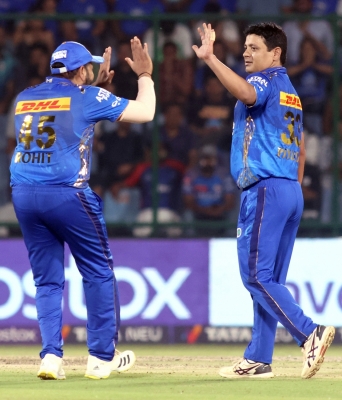New Delhi: In Mumbai Indians’ last-ball thrilling six-wicket win over Delhi Capitals at the Arun Jaitley Stadium, veteran leg-spinner Piyush Chawla put out a performance which was a throwback to his initial years of being a force to reckon with in the Indian Premier League (IPL).
Delhi had a productive power-play with 51/1, till they ran into Chawla on a dry pitch having some bit of turn for the spinners. After giving eight runs in his first over, Chawla took out Manish Pandey, Rovman Powell and Lalit Yadav to end up with 3/22 in an uninterrupted spell for Mumbai’s lead spinner.
He attributed his strong showing to consistent match practice, which had been hard to find after not being picked by any teams in the IPL 2022 player auction and becoming a commentator. “I am somebody who prefers bowling four overs in the match than bowling in the nets. You actually get to know whether a ball is a good ball or bad ball in a match. So I make sure I am playing a lot of matches, whenever I get the time.”
“Whenever the good tournaments happen — the one in Delhi you mentioned (All India SPJ Cup Season 2) and then the DY Patil in Mumbai — so I played those and also played domestic white-ball games for Gujarat. So those are enough games for me to prepare myself. And then obviously I make sure I am working on my fitness as well,” he said in the post-match press conference.
In his spell, Chawla focused bowling on good length areas and bamboozled the three Delhi batters with flight and variation, proving that he’s still capable of being effective in shortest format of the game. Pandey had been using his feet to counter spinners, but against a tossed-up leg-break from Chawla, he danced down the pitch, but was unable to get the timing right and holed out to long-off.
Delhi’s promotion of Powell was always going to backfire, considering the poor returns the big-hitter had against facing leg-spin. Chawla first threw a googly which was inside-edged to the pads, followed by missing a slider, before a googly trapped Powell plumb lbw. He signed off by foxing Lalit through flight and uproot his leg-stump with a slower googly.
“I am not playing much cricket, like domestic and competitive cricket, but I make sure, like whatever games I can play, I just put more than 100 per cent of my body on the line because sometimes what happens when you go to a local game or a club game, you just go, and you tend to lose your self-confidence.”
“You just come and bowl, but I make sure I am bowling with my full potential and what I can do for the team.” If you talk about watching cricket, then I don’t watch much cricket to be very honest because I feel if you bowl a good ball it’s a good ball in any format and for any batter. So I just prepare myself and make sure to strengthen my areas which have helped me in my career.”
“Everyone knows that PC is coming he’s gonna bowl a wrong one (googly), but still I end up getting wickets on wrong ones so I am more than happy doing that,” elaborated Chawla.
Chawla, a member of India’s 2007 T20 World Cup and 2011 ODI World Cup winning teams, thinks leg-spinners have a crucial role to play in T20s. “In the last few years of how T20 cricket was played, 160-170 used to be a good score. But it is not the same anymore unless there is some help with the wicket, then 170 is a good score; otherwise, 190 or something. So, in short, every bowler is getting hit.”
“But leg spinners are a wicket-taking option for a team, as you can use them anytime in the game. I have seen that most teams don’t use leg-spinners in the powerplay, but I have bowled in that phase so many times.”
“In such a format, you need to take wickets frequently. We have seen matches with a run rate of 14 and 15 runs per over be chased. So the wicket-taking ability of a leg spinner is as crucial as that of any bowler who must take wickets through a little bit of change in wrist usage and that brings a natural variation.”
Just like other players from both teams, Chawla too believed that the pitch wasn’t an easy one to bat on and credited the 71-run opening stand between skipper Rohit Sharma and Ishan Kishan for setting the platform to chase down 173, though it came off the last ball of the chase.
“Surya’s form was never a concern. It takes only 10 balls to make a comeback in this format, you hit four fours and you are back in form. He got out on the first ball… that happens, the situation was such. That could have been a four or a six too so this happens. But the kind of batter Surya is, he’s high on confidence and it’s only a matter of 10 balls he’ll be back to his form.”
“As Rohit (Sharma) mentioned about the batting, this pitch (Arun Jaitley Stadium) wasn’t easy to bat on. All of us, myself included, thought 170 was as good as 190 on this particular wicket. But the way Rohit batted alongside Ishan and gave us a great start by taking on the new ball was significant for us.”
“Scoring 70 runs in six overs is a great start, and that set the momentum for the chase. Even after the great start, the chase went to the last ball, so you can understand that pitch was not that easy to play on. All of them batted greatly, the way Tilak batted,” he concluded.
–IANS


Comments are closed.